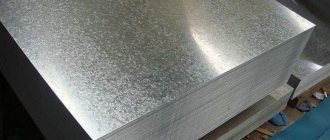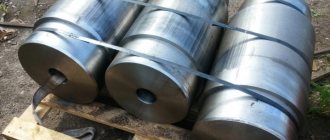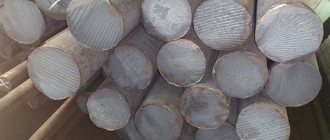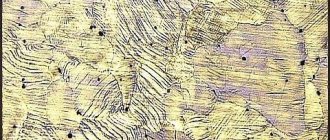Application of CVG
The very name “instrumental” determines the use of this brand. But what properties provide it with such a purpose? First of all, its resistance to warping during hardening, to which it is necessarily subjected, and corrosion resistance.
- Since HVG steel does not deform, high-precision measuring instruments of any length are made from it.
- Resistance to scale formation allows products made from this steel to be subjected to thermal operations in an already ground form, which also makes it possible to produce tools without allowances for final machining (i.e. grinding).
- The wear resistance of the surface and the toughness of the middle are determined as steel for the manufacture of parts subject to dynamic loads, for example, spring shock absorber rings.
- The corrosion resistance of HVG is ensured by the chromium content; it is relevant in the manufacture of almost any tool and spare part.
- High strength is used for the manufacture of parts for rolling mills and cold drawing. These are punches, rolls, thread gauges, etc.
- Wear resistance and strength are the main characteristics used for all parts, including lock washers.
What the HVG steel grade does not have is heat resistance, the ability to retain its properties, in particular hardness, at high temperatures. This condition is necessary for cutting and high-speed tools, where the edge temperature can reach 650 ºC. The softening of the cold hardening agent occurs at a temperature of 200 ºC, so it is used only for parts operating in the low temperature range.
- calibrated and ground rods;
- silver coin;
- thick sheets;
- stripes;
- forgings;
- blanks;
- slabs.
Usage
And in order for all the material presented below to become more understandable to you, it’s worth starting with why this alloy is used in general. Due to its special characteristics, the use of HVG steel is most often observed in the manufacture of high-precision measuring instruments, such as the familiar calipers, as well as long cutting tools such as taps, broaches, drills or reamers.
Such a list allows us to safely say that HVG is a high-strength steel suitable for processing other, softer types of metal. Also, do not forget that as the length of the product increases, the chance of its deformation increases. And since extended products are made from the HVG steel grade, we can conclude that it has increased resistance to deformation.
To learn in more detail about what the steel we are interested in is, let’s turn to the regulatory documents that mark the HVG grade as alloy tool steel. Even this seemingly very short formulation gives us some information. The fact is that tool steel is the steel in which the carbon content exceeds 0.7%. Alloy steel is an alloy of iron, carbon and some other additives designed to improve the structure of the steel.
Oddly enough, we can also find out a little about the alloying elements present in the composition of cold gases. To do this, you should turn to the GOST system, which states that each such element is assigned a specific letter designating it. Thus, we know that the composition of HVG steel includes:
- X – chromium;
- B – tungsten;
- G – manganese.
Decoding steel HVG
The HVG grade is the base grade for analog pearlitic steels. Its chemical composition is ensured by a minimum amount of alloying elements (4 in total):
- carbon - ± 1.0%;
- chromium - 0.9-1.2%;
- silicon - 01-0.4%;
- tungsten - 0.2-1.6%.
The remaining elements are of secondary importance and are maintained in the following concentration:
- manganese - 0.8-1.1%;
- molybdenum up to 0.3%;
- nickel - up to 0.35%;
- copper - up to 0.3%.
Since HVG grade steel belongs to the high-quality class, the content of harmful impurities of phosphorus and sulfur is regulated to 0.03% (this is the minimum possible limit). Residual oxygen is deoxidized with the introduction of alloying elements Si and Mn.
Influence of elements on properties
The properties of steel are influenced by two components:
- concentration of chemical elements, i.e. chemical composition of steel;
- their interaction with each other, as well as in relation to the main element (in this case Fe), which is determined by heat treatment.
Modifying materials are introduced into the melt in order to fill the crystal lattice in a certain way and thereby determine its properties. These concepts include:
- Strength - any distortion of the crystal lattice increases this characteristic;
- Increasing the hardening layer - uniform temperature distribution;
- Reduction of deformations - complete crystal lattice;
- Tendency to crack formation - here we mean strong intercrystalline bonds, i.e. the formation of carbides along grain boundaries, it can also be the formation of segregations.
Foreign analogues
Metallurgical plants smelt steel not only in the CIS countries, but also far abroad, and it just so happens that the same steel, or its “relatives” of similar composition, is found every now and then in some distant country. This is no longer uncommon and, for example, those who are forced to work with certain foreign suppliers are forced to know what material they are actually dealing with. Well, for people who are less burdened, you can use the following list of foreign analogues of HVG steel:
- USA - 01 or T31507;
- Europe - 107WCr5;
- China - CrWMn;
- Japan - SKS2 or SKS3.
With this small list at hand, anyone will be able to determine what kind of steel a particular tool made abroad is made of.
Source
Heat treatment of the HVG brand
HVG steel is subjected to the following types of heat treatment:
- Annealing - used to soften steel before machining. This procedure is used if necessary, namely, if the workpieces have been subjected to cold deformation.
- Hardening is carried out after final machining, i.e. after manufacturing a part (tool, etc.), giving it its final shape, without taking into account grinding. The workpiece is heated to temperatures of 830 ºC and cooled by immersion in oil. After this, the crystalline bonds change and the martensitic structure, very strong and brittle, predominates. To break such a part, it is enough to apply muscular force.
- Relieve internal tension and eliminate unwanted consequences with the help of vacation. This is heating and holding the metal at a temperature below ... transformations, specifically for this steel it is 180 C with cooling in air. Coagulation of martensite needles occurs and the formation of a sorbitol or troostite structure, which is the most durable and ductile.
Technology
If you get your hands on a sample of HVG steel and you decide to make something from it, some knowledge in the field of metalworking will be very useful to you. Particular attention should be paid to temperature. Indeed, depending on what temperature regime you use for processing, the characteristics and use of HVG steel at the end of the process can change greatly. To protect you from this, below we will describe the main technological processes associated with heat treatment and recommendations for their implementation.
Annealing. It is produced at the very beginning, that is, before any mechanical processing of the product. Annealing is intended to level the initial hardness of the alloy and facilitate subsequent machining. For HVG steel, annealing occurs at a temperature of 800 °C, followed by a decrease in temperature at a rate of 50 °C/hour and up to 500 °C. Afterwards the product is cooled to room temperature in air.
Alloy steel HVG
In the metallurgical industry, HVG steel is an indispensable material. High demand for steel has arisen due to its good strength and low cost, and the alloy itself is used to make parts for the construction of buildings, tools, and spare parts for instruments and mechanisms.
However, its properties have some features:
- cannot be used for welded structures;
- there is sensitivity to internal damage (flocks);
- low tendency to become brittle after tempering;
- the hardness of the object is HB10 -1 = 255 MPa.
It is possible to produce cutting components from cast parts, but their surface wears out quickly, and the element itself has poor resistance to thermal and power loads. Therefore, special requirements apply to products of this type.
Compound
The characteristics and application of HVG steel are interrelated phenomena. An alloy will not be in demand if its mechanical and physical properties do not meet specified standards. In turn, the properties of steel are set by introducing various elements from the periodic table into its composition. Therefore, it is very important to pay attention to the chemical composition of the alloy being described in order to better understand the limits of its capabilities.
It looks like this (the list contains only average values indicating the mass fraction of all elements):
- carbon – 9.5%;
- silicon – 0.25%;
- manganese – 0.95%;
- nickel – up to 0.4%;
- chromium – 1%;
- tungsten – 1.4%;
- copper – up to 0.3%.
In addition to the above additives, the alloy also contains so-called harmful alloy elements, such as sulfur and phosphorus, but their mass fraction does not exceed 0.03%, which means that their detrimental effect on the properties of steel is insignificant.
Physical and mechanical properties
The chemical composition of the metal includes 1-1.6% tungsten, which gives the element additional resistance to wear. To achieve the required hardness, chromium and carbon are added to the composition in a ratio of 1%. The presence of silicon (0.4%) increases tempering resistance, and manganese (1-2%) ensures the integrity of the structure.
CVG itself has the following characteristics:
- at T=20 °C the density of the product will be 7850 kg/m3;
- with a temperature of 100 °C, the coefficient of linear expansion (a10 6) will be 11 DEGREES, and the density will decrease by 20 units;
- at T=200 °C a10 6 will be 12;
- when heated to 600°C, the expansion will reach 14.5 degrees, and “p” will decrease to 7660.
It is important to note that carbon is the main component of CVG , which should be at least 1%. This value turns out to be overestimated, which distinguishes this brand from the rest.
An important indicator is corrosion resistance, which makes it possible to use rolled metal to create complex units. The general chemical structure is as follows:
All compounds are added in such a proportion as to provide the ingots with better hardenability, reduce deformation and eliminate the likelihood of cracks. The result is high-grade carbon steel.
Usage
And in order for all the material presented below to become more understandable to you, it’s worth starting with why this alloy is used in general. Due to its special characteristics, the use of HVG steel is most often observed in the manufacture of high-precision measuring instruments, such as the familiar calipers, as well as long cutting tools such as taps, broaches, drills or reamers.
Such a list allows us to safely say that HVG is a high-strength steel suitable for processing other, softer types of metal. Also, do not forget that as the length of the product increases, the chance of its deformation increases. And since extended products are made from the HVG steel grade, we can conclude that it has increased resistance to deformation.
To learn in more detail about what the steel we are interested in is, let’s turn to the regulatory documents that mark the HVG grade as alloy tool steel. Even this seemingly very short formulation gives us some information. The fact is that tool steel is the steel in which the carbon content exceeds 0.7%. Alloy steel is an alloy of iron, carbon and some other additives designed to improve the structure of the steel.
Oddly enough, we can also find out a little about the alloying elements present in the composition of cold gases. To do this, you should turn to the GOST system, which states that each such element is assigned a specific letter designating it. Thus, we know that the composition of HVG steel includes:
- X – chromium;
- B – tungsten;
- G – manganese.
Decoding the abbreviation
From the name you can determine the main components that give iron special properties. In this case, the following decoding is done using the CHVG symbols : The sign “X” means the presence of chromium (Cr), “B” means vanadium (V), “G” means manganese (Mn). Many construction devices can be made from ingots, but they must strictly comply with all state standards. For example, calibrated rods are allowed to be produced only in accordance with GOST 8560-78, 8559-75, 7417-75, 5950-2000. For rough or intermediate parts, 1133-71, 7831-78, 5950-2000 standards are used.
Hardening – critical diameter, mm
| H.R.C. | On air | In water | In saltpeter | In oil |
| 60 | – | – | 15–40 | 15–70 |
| t | r | R 109 | E 10-5 | l | a 106 | C |
| 0C | kg/m3 | Ohm m | MPa | W/(m deg) | 1/Grad | J/ (kg deg) |
| 20 | 7850 | 380 | ||||
| 100 | 7830 | 11 | ||||
| 200 | 12 | |||||
| 300 | 7760 | 13 | ||||
| 400 | 13,5 | |||||
| 500 | 14 | |||||
| 600 | 7660 | 14,5 |
| Bulgaria | Hungary | Germany | European Union | Spain | Italy | China |
| BDS | MSZ | DIN, WNR | EN | UNE | UNI | G.B. |
| ChWG |
W9
1.2419
| 105WCr6 |
107WCR5
105WCR5
107WCr5KU
CrWMn
| Poland | Romania | USA | France | Sweden | South Korea | Japan |
| PN | STAS | — | AFNOR | SS | KS | JIS |
| N.W.C. |
105MnCrW11
01
| T31507 |
105WC13
| 105WCr5 |
| 106WCr6 |
| 90MCW5 |
2140
STS2
| STS3 |
| STS31 |
SKS2
| SKS3 |
| SKS31 |
| S.K.S.A. |
HVG grade steel is used for the manufacture of cutting/measuring tools, for which increased warping during hardening is unacceptable.
Application options
Almost any construction work is carried out using measuring and cutting devices, and using different technologies:
- To make holes in various surfaces, drills are used, which can be either standard screw or flat.
- The operation of thread gauges allows you to find out the real geometric parameters of the workpieces.
- Taps can be used to make threads in connectors.
- Broaches can be used to process shaped planes.
There are many more tools, the production of which is characterized by the use of carbon steel HVG . But for such objects, increased warping during hardening is unacceptable.
It is also customary to make accessories from rolled metal for accurately determining geometric dimensions, which include a micrometer, calipers, depth gauge and others. During construction work, they will be subjected to strong mechanical stress, which may disrupt their original shape and make further use impossible. Such devices must be very durable, so they are made from this metal or other analogues.
Compound
The characteristics and application of HVG steel are interrelated phenomena. An alloy will not be in demand if its mechanical and physical properties do not meet specified standards. In turn, the properties of steel are set by introducing various elements from the periodic table into its composition. Therefore, it is very important to pay attention to the chemical composition of the alloy being described in order to better understand the limits of its capabilities.
It looks like this (the list contains only average values indicating the mass fraction of all elements):
- carbon – 9.5%;
- silicon – 0.25%;
- manganese – 0.95%;
- nickel – up to 0.4%;
- chromium – 1%;
- tungsten – 1.4%;
- copper – up to 0.3%.
In addition to the above additives, the alloy also contains so-called harmful alloy elements, such as sulfur and phosphorus, but their mass fraction does not exceed 0.03%, which means that their detrimental effect on the properties of steel is insignificant.
Heat treatment
This term refers to the process of temperature exposure, which makes it possible to improve the attributes of hard alloys. Metals of various categories can undergo heat treatment, but each type requires a specific approach. There are several types of these manipulations:
- Hardening. The peculiarity of this procedure is heating to critical degrees with rapid cooling of the part. Such extreme changes give the surface of the object increased strength. When hardening HVG, the furnace is heated to 830 °C, and after heating it is cooled in oil.
- Annealing. This class is similar to the previous one, only cooling should be gradual, preferably in the open air. The main objective of the method is to reduce density for ease of further mechanical processing.
- Cryogenic. Here the object is exposed to low temperatures, which can be below -150 °C. Thanks to this approach, it is possible to increase the wear resistance of elements.
The latter method is applicable for the production of brake discs, blades, clutch discs and other spare parts. From this we can conclude that this material is not frozen. And heat treatment of HVG steel in a standard furnace seems to be a more popular option.
Source
Technology
If you get your hands on a sample of HVG steel and you decide to make something from it, some knowledge in the field of metalworking will be very useful to you. Particular attention should be paid to temperature. Indeed, depending on what temperature regime you use for processing, the characteristics and use of HVG steel at the end of the process can change greatly. To protect you from this, below we will describe the main technological processes associated with heat treatment and recommendations for their implementation.
LLC "Industrial Metal"
| Exchange Rates |
5ХНМ f280 circle kov.
34ХН1М f75, f80 circle forged.
Available inexpensively:
Art. U12A f4.45mm; f4.6mm silver
Art. 20Х12ВНМФ EP428 f30 circle
Art. 25Х2М1Ф 230х230х270 forgings st. 40Х 280х280 sq. blank Forging st. 38Х2Н2МФА f480х85 Strip 09G2S 60х310 Hexagon 65 st. 12ХН2
9ХС is a tool steel with a high content of carbon and alloyed additives in the form of chromium and silicon. The name itself suggests that this material is used to make instruments. A sufficient percentage of carbon allows you to obtain a high degree of hardening, which makes it possible to use steel for the manufacture of knives with high performance.
Heat treatment features
This action occurs by heating followed by cooling, and its task is to obtain the necessary attributes due to changes in the internal structure. Such an operation is resorted to at an intermediate or final stage of work, and with the operation of a special furnace. Heating time plays a key role, since carbon, which is responsible for the hardness of the object, is removed from the components.
Properties of 9xc at elevated temperatures
Heat treatment directly affects its strength:
- At T=170-200 °C HRC=63-64;
- At T=200-300 °C HRC=59-63;
- At T=300-400 °C HRC=53-59;
- At T=400-500 °C HRC=48-53;
- At T=500-600 °C HRC=39-48.
The main thing to know is that after heating in a furnace, the steel is cooled in oil, and things will tend to become brittle when tempered. In other cases, cryogenic processing is used, which is carried out at low temperatures.
Spring knife
A knife is a great thing that can be useful not only as an excellent tool, but also as a wonderful souvenir. Every boy will be happy with such a gift. If a knife is made by hand, it immediately becomes a unique value in the eyes of the owner.
Adults also do not always use knives exclusively for household purposes - many people collect them. Everyone’s selection criteria are different, but everyone knows that high-quality steel is a prerequisite for a good knife. But a beautifully crafted handle can make no less an impression than a durable blade that can hold an edge for a long time.
Substitute steels
Such a developed and comprehensive industry as metallurgy simply cannot afford to produce one specific grade of steel as a universal one, so over time more and more alloys appeared, the differences between which were not so significant. In everyday life, such steels are boldly called substitutes. And for HVG steel in the domestic space there are the following substitute brands:
9ХС; 9ХВГ; HVSG; SHH15SG.
This list presents alloys that are fundamentally very similar, but have differences either in the percentage of impurities or in their set itself, which, in general, slightly distinguishes the steels from each other.










